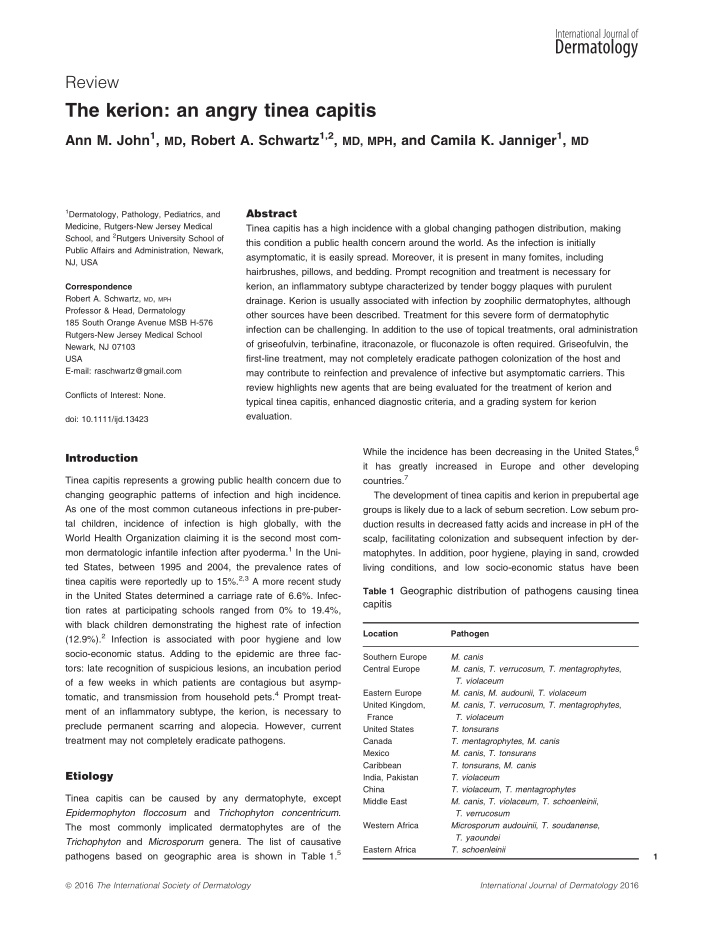



Review The kerion: an angry tinea capitis Ann M. John 1 , MD , Robert A. Schwartz 1,2 , MD, MPH , and Camila K. Janniger 1 , MD Abstract 1 Dermatology, Pathology, Pediatrics, and Medicine, Rutgers-New Jersey Medical Tinea capitis has a high incidence with a global changing pathogen distribution, making School, and 2 Rutgers University School of this condition a public health concern around the world. As the infection is initially Public Affairs and Administration, Newark, asymptomatic, it is easily spread. Moreover, it is present in many fomites, including NJ, USA hairbrushes, pillows, and bedding. Prompt recognition and treatment is necessary for kerion, an inflammatory subtype characterized by tender boggy plaques with purulent Correspondence Robert A. Schwartz, MD , MPH drainage. Kerion is usually associated with infection by zoophilic dermatophytes, although Professor & Head, Dermatology other sources have been described. Treatment for this severe form of dermatophytic 185 South Orange Avenue MSB H-576 infection can be challenging. In addition to the use of topical treatments, oral administration Rutgers-New Jersey Medical School of griseofulvin, terbinafine, itraconazole, or fluconazole is often required. Griseofulvin, the Newark, NJ 07103 USA first-line treatment, may not completely eradicate pathogen colonization of the host and E-mail: raschwartz@gmail.com may contribute to reinfection and prevalence of infective but asymptomatic carriers. This review highlights new agents that are being evaluated for the treatment of kerion and Conflicts of Interest: None. typical tinea capitis, enhanced diagnostic criteria, and a grading system for kerion evaluation. doi: 10.1111/ijd.13423 While the incidence has been decreasing in the United States, 6 Introduction it has greatly increased in Europe and other developing countries. 7 Tinea capitis represents a growing public health concern due to changing geographic patterns of infection and high incidence. The development of tinea capitis and kerion in prepubertal age As one of the most common cutaneous infections in pre-puber- groups is likely due to a lack of sebum secretion. Low sebum pro- tal children, incidence of infection is high globally, with the duction results in decreased fatty acids and increase in pH of the World Health Organization claiming it is the second most com- scalp, facilitating colonization and subsequent infection by der- mon dermatologic infantile infection after pyoderma. 1 In the Uni- matophytes. In addition, poor hygiene, playing in sand, crowded ted States, between 1995 and 2004, the prevalence rates of living conditions, and low socio-economic status have been tinea capitis were reportedly up to 15%. 2,3 A more recent study Table 1 Geographic distribution of pathogens causing tinea in the United States determined a carriage rate of 6.6%. Infec- capitis tion rates at participating schools ranged from 0% to 19.4%, with black children demonstrating the highest rate of infection (12.9%). 2 Infection is associated with poor hygiene and low Location Pathogen socio-economic status. Adding to the epidemic are three fac- Southern Europe M. canis tors: late recognition of suspicious lesions, an incubation period Central Europe M. canis , T. verrucosum , T. mentagrophytes , T. violaceum of a few weeks in which patients are contagious but asymp- tomatic, and transmission from household pets. 4 Prompt treat- Eastern Europe M. canis , M. audounii , T. violaceum United Kingdom, M. canis , T. verrucosum , T. mentagrophytes , ment of an inflammatory subtype, the kerion, is necessary to France T. violaceum preclude permanent scarring and alopecia. However, current United States T. tonsurans treatment may not completely eradicate pathogens. Canada T. mentagrophytes , M. canis Mexico M. canis , T. tonsurans Caribbean T. tonsurans , M. canis Etiology India, Pakistan T. violaceum China T. violaceum , T. mentagrophytes Tinea capitis can be caused by any dermatophyte, except Middle East M. canis , T. violaceum , T. schoenleinii , Epidermophyton floccosum and Trichophyton concentricum . T. verrucosum Western Africa Microsporum audouinii , T. soudanense , The most commonly implicated dermatophytes are of the T. yaoundei Trichophyton and Microsporum genera. The list of causative Eastern Africa T. schoenleinii pathogens based on geographic area is shown in Table 1. 5 1 ª 2016 The International Society of Dermatology International Journal of Dermatology 2016
Recommend
More recommend